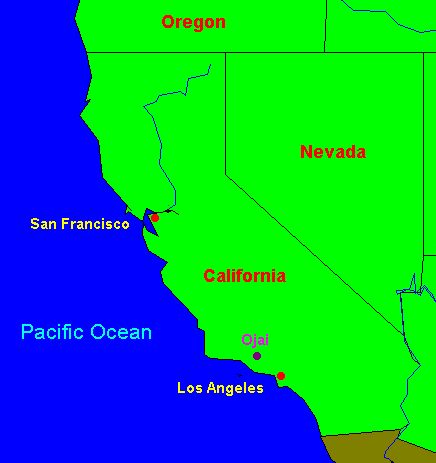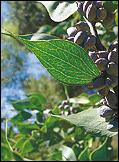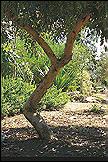|
[Front Page] [Features] [Departments] [SGAP Home Page] [Subscribe]

A Protean Garden in California
Andrew Wilson
With a name like yours, you might be any shape, almost
Lewis Carroll, "Through the Looking-Glass"
A visit to a new garden always causes excitement. Anticipation quickens on approach, while looking for clues to its presence in neighbouring landscapes and gardens. Neighbours will grow special plants that have proven successful in the area; those plants lead to the quarry. In North Wales they may be embothriums, in Los Angeles silk floss trees. Old roses are a sure lead: climbing roses may be a blind alley. Hints of this kind were missing as I drove through foothill oak woodland recently and emerged into a valley of flowers. Taken by surprise my excitement was derived not from anticipation fulfilled, but from confrontation with the unexpected. There, above Lake Casitas near Ojai, a new world opened, too new and isolated to have left clues in the approach.
John and Melody Taft began their garden a little more than ten years ago. After clearing the land to add a few more acres of citrus and avocado to the state's agricultural reserves, they paused and realized that it offered a grander opportunity. About ten miles from the coast and protected from the north by the Transverse Ranges, the gardens enjoy conditions which are similar to those found near the Cape of Good Hope. The original intentions to grow South African proteas soon expanded into developing a garden with a much wider range of plants, primarily from the Cape Province. The plantings developed successfully, inducing expansion to include a section for Australian plants, again with emphasis on proteas.
Above the main garden but separated from it the house provides privacy from the activities of the International Center for Earth Concerns in whose grounds the garden is situated. The separation creates more than mere privacy, however. Below the house the steep terrain is clothed in great banks of aloes, kalanchoes, senecios and crassulas that provide a fire-break in fall and a blaze of brilliance in spring. The area just around the house itself is devoted to Sonoran plants - cereus, saguaros, giant barrel cactus and agaves. They stand guard about its stone walls, offering no encouragement to fire.
 
Ojai (pronounced "Oh-hi") is located in a picturesque area about 100 km north-west of Los Angeles.
The garden has been close to disaster on several occasions. In its initial stages a fire in the adjacent Los Padres Forest swept down the foothills, engulfing the area in flames. Vegetation returned with winter rains. A second mishap took place after both gardens had been planted. During the winter of 1989-90 severe frosts devastated many gardens of the Northern and Central coasts and came also to the Ojai Valley. Arctic airs, falling at night time to 18 degrees F (-8 degrees C), caused the "meltdown" of many succulents and cut back numerous shrubs to near ground level. Such conditions are rare and the losses did not change intentions for the gardens which are now, in effect, just six years old. The growth achieved in that time has been impressive. Part of this success results from the deep, scree-laden soil. With humus built up for many centuries by chaparral, the soil is both friable and fast-draining. While not important for the Cape succulents the deep soil is critically important for the proteas, ensuring them moisture until autumn.
The garden design is casual. Pathways, few and widely separated, meander throughout. Stones border them and larger rocks, also cleared from the top surface of scree, form low, dry walls. These provide a unifying feature of the gardens besides defining the boundary between exotic plants and native chaparral. Like those of other rock-strewn landscapes, the walls also serve a more mundane purpose - they are a place to put the gathered rocks.
The South African garden began through the seeding of many succulent species over much of the area followed by the planting of bulbs, composite perennials and shrubs. This took place nearly ten years ago under the supervision of Laurence Nicklin who has since returned to Cape Town. Within a few years over five acres of landscape resembling the fynbos and karoo succulent regions had been formed. Then the expansion of the gardens to include plants from Australia took place. Fresh from the bush, Jo O'Connell arrived with seeds and cuttings. Aided by a small crew of gardeners, she laid out and planted a bushland garden of over five acres and a smaller area of rainforest plants from Queensland, all in a single year. She has since launched a nursery in Casitas Springs, near Ojai, California specializing in Australian plants.
 |
The large soft leaves of, Acacia cowleana, a species from northern Australia. Select the thumbnail image or plant name for a higher resolution image (42k). Photo: George Waters
|
A Cape Province Garden
A low density of planting creates an open, sparse appearance with areas of massed ice plants, gazanias and Namaqualand daisies separating groups of shrubs and small trees. Bulbous plants spring forth between rocks. In early spring the coral aloes burst into sheets of brilliant pink and orange. Spreading by offsets, they colonize large sections. When not in bloom their smooth, succulent leaves, ranging in colour from silver-pink to flesh tones seem threatened by the sharp, brown scree.
Pathways are few, as if to avoid the appearance of a garden and to create an image of the veld. Narrow paths are rocky and really serve only the drainage of water during winter. Giant candelabra aloes stand as guides to assist the traveller amid the dazzling colours and jagged rocks. Later in the year kokerbooms take on this role.
Gray cotyledons and crassulas soften the stark shapes and colours of the succulent display. They cover the ground in clumps, but more densely and with greater uniformity than do the aloes. In the brilliant landscape tones change rapidly as the sun rises in the sky. Early morning or late afternoon shadows accentuate the colours of sparse, low profile plant groups.
At midday a live-oak breaks the glare. In its shade, forest spur-flowers offer purple balm to blinded eyes. These plants come from moister areas along the southern coast of Africa. They grow rapidly and flower well even in deep shade so long as they get some moisture in summer.
Beyond the oak stand bushes of pincushion flowers. The yellow-flowered form of the rocket pincushion, with its startling, citron blossoms and grey-leaved stems is becoming better known by flower-buyers, if not the gardening public. Another is Catherine's pincushion, which has flowers up to five inches across and curved, pale yellow petals. These plants grow well here in the fast-draining soil provided that they, like other proteas, do not receive the well-intentioned blessings of a general fertilizer. A much smaller bush, the pink and white blushing bride blooms demurely in the shade of its taller relatives. This is a much more delicate plant in form. Indeed, it is also more delicate in constitution. Hopeless for hot areas with alkaline water, it is growing well here in open shade.
An Australian Garden
Higher up the valley the fynbos merges with the bush. The landscape change is dramatic. Instead of succulents and daisy carpets, shrubs and small trees dominate the scene. With their unusual flower forms and plant shapes they are highly varied, giving interest and colour to the garden all year rather than a blaze of springtime glory.
 |
The intricately veined foliage of Hakea victoria Select the thumbnail image or plant name for a higher resolution image (44k). Photo: George Waters
|
Wandering through the formless bush, one is drawn more by the attraction of plants in flower and the allure of unusual form than by the dictates of ordered pathways. Passing each large shrub a new scene appears. Banksias with golden brushes introduce you to groups of grevilleas with red and buff-colored plumes. Interspersed with dwarf melaleucas, bluebell creepers and bright pink boronias the tall hakeas stand like stiff sentinels. The leaves of some species are heavily veined. A wattle from the northern desert draws you to touch its large, soft, silvery leaves. Bereft of markings this bushland attracts attention to features of individual plants rather than to the broader view. It causes the stranger to lose direction.
 |
The stiff flower heads of Banksia ashbyi Select the thumbnail image or plant name for a higher resolution image (45k). Photo: George Waters
|
Distances between plants are wide but some specimens have attained, within five years, dimensions expected at maturity. Thus, the bush appearance is less open than you might find on the great sandplains of Western Australia. With time, it may become more like that of open woodland. It is also surprising how, at such an early age, a sense of maturity has been reached. Seedlings spring up in their parents' shade.
Unlike many Californian gardens this one harbours no giant eucalypts. The absence was intentional; imposing frames cause shadows and close in the skies. Their place in the landscape is held by the mallee eucalypts. As denizens of the open bush, they are generally not more than fifteen feet tall. Free of lawn irrigation in the garden they are sturdy and resilient to the wind, a feature of interest to those who must suffer the fallen branches of the larger gums. Small eucalypts, including mallees, are the real characters of the bush. Some, such as the coral gums are highly colourful in winter and spring. I saw one specimen with masses of red flowers and yellow anthers attracting bees to its nectar. Others present images ranging from the bizarre, as in the silver-leaved mountain gum which I have heard described as a parrot perch, to the merely odd, as in the dwarf bushy sugar gum from Kangaroo Island. In these gardens the former has unusually small, white leaves with sparse, broadly arching branches. The latter, whose trunk commonly develops a crook against the wind, assumes the charm of a bent umbrella.
Toughness and vigour are features of many of Australia's plants in California. By mid-March named forms of tea tree were starting to form buds that will open as pink flowers more than an inch across. These plants are eight feet tall and even greater width in six years. They are adaptable flowering shrubs and may be useful as informal screens if their exuberant growth is curbed. A related tea tree from the Grampians Range with even larger flowers grows nearby. Also tough and vigorous is the black coral pea vine. Clambering over a boulder its large yellow and jet-black flowers are startling, if not beautiful. All these plants come from southeast Australia and enjoy moisture in summer but are also fairly resistant to drought. They are grouped around a still pond.
 |
Springtime sun on veined leaves and ripening nuts of Hakea petiolaris Select the thumbnail image or plant name for a higher resolution image (44k). Photo: George Waters
|
Mediterranean climate areas are rich in plants with grey leaves. The garden shows that, in this respect, Australia is no exception. Poverty bushes with lime-green flowers, woolly bushes with partly hidden red blooms, small leaved blue bush, helichrysum, lavender grevillea and silvery plectranthus form a dazzling group. It makes you not only stare at the white, grey and even bluish tones but also touch the silky leaves and smell the fragrances. Australian plants do not develop succulent leaves to store moisture and protect themselves from the sun; they reflect its heat with their silver leaves and radiate it away with fine hairs.
A Garden of Plants
The division of the garden into African, Australian and also Sonoran sections is unusual. It was never intended to be a botanic garden, nor has it become one. That several areas of the world should have developed plants so different from each other is clearly obvious when walking through. This may be reason enough to justify the separation. For the gardener, as distinct from the botanist, the layout has more practical implications. Anyone who has grown Australian plants knows how many of them have tough, leathery leaves that decay slowly. Growing these next to a bed of aloes or gazanias is asking for trouble.
 |
Kinky dwarf from Kangaroo Island - Eucalyptus cladolcalyx 'nana' Select the thumbnail image or plant name for a higher resolution image (70k). Photo: George Waters
|
This is a garden for an immense range of plants. They create its structure. They define the paths, the shaded places and the views. So, like the god Proteus, the garden has many faces. It is young but has old oak-trees. It is African fynbos and Australian bush. Its flowers are massed in multitudes and projected as personalities. Its leaves are succulent teardrops and sharp wedges. It is young and those faces, like California itself, will change, providing in time clues to the garden's whereabouts.
Some Plants in the Protean Garden
Common and Botanical Names
| Common Name | Botanical Names |
|---|
| Banksias | Banksia ashbyi, B.robur, B.coccinea, B.media, B.baueri, B.attenuata |
| Black coral pea | Kennedia nigricans |
| Bluebell creeper | Sollya heterophylla |
| Blushing bride | Serruria florida |
| Candelabra aloes | Aloe candelabrum, A.marlothii, A.speciosum |
| Catherine's pincushion | Leucospermum catherinae |
| Coral aloe | Aloe striata |
| Coral gum | Eucalyptus torquata |
| Dwarf bushy gum | Eucalyptus cladocalyx "Nana" |
| Dwarf melaleucas | Melaleuca pulchella, M.gibbosa |
| Forest spur flower | Plectranthus fruticosus |
| Grampian's tea tree | Leptospermum turbinatum |
| Grevilleas | Grevillea lavandulacea, G."Red Hooks", G."Poorinda Blondie" |
| Hakeas | Hakea cucullata, H.petiolaris, H.francisiana, H.victoria |
| Helichrysum | Helichrysum paralium |
| Kokerboom | Aloe dichotoma |
| Pink boronia | Boronia molloyae |
| Poverty bush | Eremophila latrobei glabra, E.glabra "Ouyen" |
| Silk floss tree | Chorisia speciosa |
| Silvery plectranthus | Plectranthus argentatus |
| Small-leaf bluebush | Maireana brevifolia |
| Tea trees | Leptospermum rotundifolium "Jervis Bay", "Manning's Choice" |
| Woolly bush | Adenathos sericeus |
| Yellow rocket pincushion | Leucospermum reflexum "Flavum" |
|
This article is reproduced with permission from the Fall 1996 issue of "Pacific Horticulture" published by the Pacific Horticultural Foundation, PO Box 22609, San Francisco, Ca 94122, USA.
Andrew Wilson, a member of the West Australian Wildflower Society for over ten years, lives in San Diego, California. A physicist by training and a horticulturist by avocation, he has planned and created gardens in Ireland and California. A lifelong theme carried out in those informal gardens was to grow plants that accept local conditions without the need for heroic measures. In Ireland they were Chilean and New Zealand plants, in California they are Australian, South African and Californian natives.

[Front Page] [Features] [Departments] [SGAP Home Page] [Subscribe]
Australian Plants online - March 1998
The Society for Growing Australian Plants
|